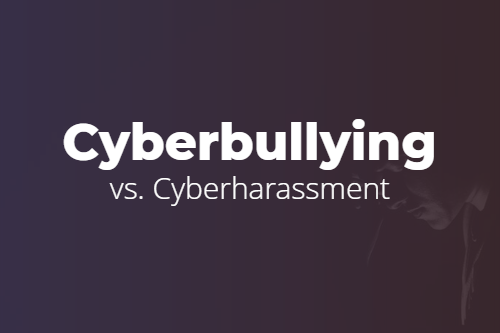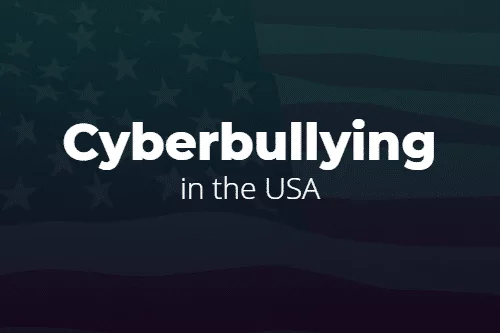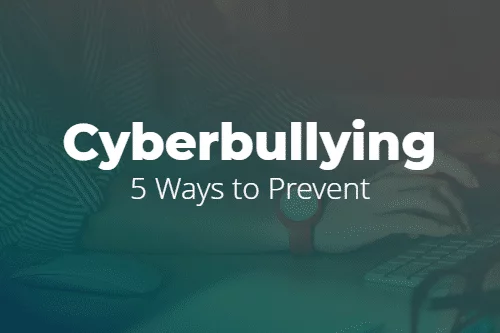
What is Cyberbullying? How to Prevent Cyberbullying
This page has been peer-reviewed, fact-checked, and edited by qualified attorneys to ensure substantive accuracy and coverage.
Whether in elementary school or the office, anyone who has ever dealt with a bully knows how humiliating and traumatic it can be. These days, bullying has moved from playgrounds and break-rooms to the Internet. Just like confronting a schoolyard bully, it helps to have friends in taking on an online bully. And we’re here to help and back you up.
In this comprehensive blog post, we’re going to walk you through the definition of cyberbullying, how it differs from cyberharassment and cyberstalking, whether it’s illegal in the U.S., how to prevent cyberbullying, and more!
- If you’re wondering how to stop cyberbullying and cyberharassment, we recommend adhering to the following steps:
- Talk to your child about what constitutes cyberbullying and online harassment,
- Preserve all relevant evidence and communications relating to the cyberbullying incident,
- Protect all online and social media accounts,
- Familiarize yourself with your state’s respective cyberbullying and harassment laws.
Head over to Section 3 of this article to learn more about stopping cyberbullying and cyberharassment!
Cyberbullying Protection Tip: There are countless risks associated with social media platforms, applications, and websites today, so make sure to remain vigilant of you and your child’s social media profiles. Who are they interacting with? Is there profile set to public or private? Are they sharing extremely personal information online? Unfortunately, an estimated one million are cyberbullied, harassed, and threatened on Facebook every year.
If you or your child has been the victim of workplace bullying, school bullying, or other cyberbullying, contact the Internet defamation attorneys of Minc Law as soon as possible. We’re here to help put an end to the online harassment and cyber-attacks NOW!
Contact us today to schedule your free, initial no-obligation consultation with an intake specialist by calling us at (216) 373-7706, or by scheduling a meeting online!
With a team of experienced attorneys, we will fight for the closure you deserve. Take back control today.Don't suffer in silence.

How is Cyberbullying Defined? Cyberbullying vs. Cyberharassment
Simply put, cyberbullying is defined as the online bullying and harassment of a minor (a person under the age of 18), and includes all electronic communications and devices used to stalk, attack, or harass a person or organization. It is also commonly referred to as cyberharassment, internet bullying, and online bullying. However, do note that cyberharassment is typically used to describe the online harassment and bullying of adults rather than minors.
Common examples of bullying behavior include:
- Spreading of rumors,
- Direct and indirect threats,
- Sexual comments and remarks,
- Disclosure of an individual’s confidential information,
- Pejorative designations.
Cyberbullying, and real-life bullying, can be broken down into two fundamental elements; (1) repeated unwanted behavior, (2) with an intent to harm or cause damage to a victim. Keep in mind that it’s essential for a perpetrator’s actions to happen more than once for it to be considered cyberbullying. Otherwise it may be chalked up to a “one-off” incident or classified as a different crime.
Online bullying and cyber harassment often also include one of the following elements; defamation, libel, false accusations, invasion of privacy, or false light. It’s also not uncommon for cyberbullying to escalate to real-life bullying, which may be accompanied by far more dangerous actions, such as assault, battery, solicitation of sexual acts, stalking, identity theft, vandalism, and more. It’s estimated that 83% of cyberbullying victims have also been bullied in real-life.
Cyberbullying vs. Internet Trolling
Internet trolling is considered a subcategory of bullying over the Internet in a specific online community (think social media, online gaming, or other user-generated content platforms). Specifically, Internet trolling is a communication made by electronic means with the intent of eliciting a reaction from another person for the author’s own personal enjoyment and amusement.
Internet trolls often are motivated by drawing attention to themselves rather than the victim. Trolling is legal in the United States – unless it should ultimately cross-over into the territory of a more serious crime (ex. Online stalking, harassment, sextortion, impersonation, cyberstalking). It also generally lacks the first element at the heart of cyberbullying actions; repeated conduct and behavior.
The United Kingdom and New Zealand do however have trolling laws codified in their books, with the U.K. imposing up to a 2-year sentence for individuals to have been found to have “trolled” another.
So, what’s the reason why the United States has not criminalized trolling?
The United States is typically considered a pro-defendant legal jurisdiction when it comes to free speech actions. Specifically, the legal principle of “prior restraint,” whereby content or speech is preemptively censored or suppressed, creates one of the biggest hurdles for anti-trolling laws. Furthermore, Michael J. Brown of the TexasCriminalLawyerBlog notes the subjective nature of most trolling actions, which can be difficult to prescribe for and criminalize.
Have you been a victim of cyberstalking or Internet sextortion? Check out our past articles on how to stop cyberstalking and online harassers, and how to deal with Internet sextortion.
Online Harassment Protection Tip: Cyberbullying, Internet blackmail, and online harassment all involve a one-sided power dynamic, whereby a perpetrator wields perceived power over an innocent victim. While it might seem counterintuitive to cease all contact with an online perpetrator or cyberbullying, engaging with them only stands to worsen the situation. Do not give cyberbullies and online harassers any more power than they think they have already. You have more power than you think.

Common Methods of Cyberbullying in the U.S.
Cyberbullying isn’t always as cut and dry as one might think, especially when it’s online. Sometimes it can be difficult to ascertain whether an electronic communication, Internet device, or online platform is actually being abused.
Unfortunately, the stakes are high when dealing with online bullying and cyberharassment, with victims commonly experiencing lower self-esteem, increased suicidal thoughts, fear for one’s safety, depression, anger, and countless other negative emotional responses.
First, let’s take a look at some cyberbullying statistics to understand just how prevalent and serious this cyber-crime is in today’s day and age.
- 50% of children admitted to being scared of their online bullies,
- 92% of all cyberbullying attacks and harassment occurred via social media websites,
- Roughly 2 out of every 10 cyberbullying victims will alert a parent, teacher, or another figure of the targeted online harassment,
- Cyberbullying victims are 3 to 9 times more likely to have suicidal thoughts,
- 15% of individuals have admitted to having cyberbullied another online.
Below are several of the most common methods of Internet bullying teenagers and adolescents in the U.S. (and across the globe).
Spreading of Rumors Online
Teenagers and adolescents gossip. Rumors and falsehoods have unfortunately become the norm online and on social media platforms. While rumors might seem not worth dealing with, due to their lack of perceived seriousness, they can often escalate to online defamation and libel, which can seriously injure you or your child’s reputation.
Rumors are not illegal in the United States. They are, however, in a grey area due to their potential to rise to the level of defamation. It’s extremely important to keep an eye on the types of rumors that are being spread about you or your child online, to quickly identify if they turn defamatory, malicious, and false.
Once a rumor has escalated to full-blown online defamation and libel, you might want to consider bringing an online defamation lawsuit. We do recommend reaching out to an experienced online defamation attorney before initiating a libel suit to determine whether the rumors in question have gone beyond their protected bounds.
Disclosure of Victim’s Personal Data & Information
Commonly referred to as “doxing,” the disclosure of a victim’s personal data and information is a common form of cyberbullying, and one that severely stands to impact you and your child’s life. Not only could the dissemination of such highly private information lead to strangers knowing where you live, it can also result in the creation of fake online profiles and accounts, financial fraud, and identity theft.
The disclosure of you or your teenager’s private information could give rise to a lawsuit for invasion of privacy – a Common law tort protecting individuals who have had their private affairs intruded on and personal information disclosed to the public.
Additionally, doxing can lead to harassment in person, fake registration of giveaways and mail services, or swatting (where police officers are dispatched to one’s address following a bogus report of a serious crime).
Workplace Bullying
So, you might be wondering how to deal with workplace bullying? First, it’s important to identify what constitutes workplace bullying. WorkplaceBullying.org defines workplace bullying, including workplace cyberbullying, as the “repeated, health-harming mistreatment of one or more persons (the targets) by one or more perpetrators.” They classify it as abusive conduct, which includes at least one of the following:
- Threats, humiliation, or intimidation,
- Work interference or sabotage,
- Verbal abuse.
With popular workplace Internet chat applications and online communication channels, workplace cyberbullying has become extremely popular over the last 15 years. To deal with a workplace bully, we recommend taking the following actions:
- Establish limits on what you can tolerate,
- Communicate your boundaries to the workplace bully,
- Document all actions and communications (specifically the date, time, and details of the incident),
- Report the bully to management or HR.
Social Media Attacks
According to a 2015 study by Pew Research Center on young adult Internet use, teenagers and young adults spend more time online and engaging with media than any other activity (besides sleeping). Social media is so deeply ingrained in today’s culture, that it should be no surprise that the most commonly used platforms for cyberbullying are social media platforms.
After all, there are an estimated 2.6 billion monthly active users on Facebook alone, as of October 2020. Users are sharing more personal information about themselves than ever, including their location, contact details, and intimate images.
Beware of accepting friend requests from strangers and profiles with minimal information and media. And, while it might seem like common sense, we recommend against sending explicit or intimate photographs and other media to complete strangers online (or anyone at all!).
Online Gaming Harassment & Bullying
Of all Internet bullying victims, 16% reported experiencing their most recent instance of cyberbullying in a video game. Does Gamergate ring a bell? Well, it should. Gamergate was a 2014 harassment campaign which made national news after several notable female game developers were threatened, harassed, and doxed online.
Online harassment and cyberbullying in the video game community has spiraled into something of an epidemic, due to its global accessibility, popular chat and communication tools, and competitive ecosystem. Online harassment and cyberbullying in video games has also resulted in swatting, whereby law enforcement SWAT units are summoned to an individual’s house as a prank – with one gamer even being killed by police officers in late 2017 as a result of a swatting prank.
Curious about some of the most popular Internet blackmail and online extortion scams? Make sure to check out our past article, “How to Report Internet Blackmail“.
Defamation Law Fact: Defamation refers to a false written or spoken statement which is communicated to a third-party, subsequently causing damage to a person’s reputation. Defamation is broken down into two specific types: libel (written) and slander (spoken). Defamation may also be commonly referred to as vilification, character assassination, traducement, and calumny.

5 Ways to Prevent Cyberbullying
Cyberbullying and other malicious online attacks can ruin one’s life, leaving you not only fearing for you and your child’s livelihood, but safety as well. And, with an estimated 95% of all teenagers connected to the Internet, 85% of which are active on social media platforms, it’s inevitable that you or your child will encounter uncomfortable (and sometimes malicious) online interactions and individuals.
Do note that if you are an adult and are the victim of adult cyberharassment, most reports are typically filed with your local police. If you’re the victim of cyberharassment and unsure of how to proceed, we recommend reaching out to an experienced Internet attorney to better assist you in gathering evidence, contacting the local police, and filing a cyberharassment police report.
In this section, we’re going to take you through five ways to prevent cyberbullying, how to craft a strategic and comprehensive cyberbullying and online harassment gameplan, and more!
1. Talk With Your Child About Cyberbullying
Education is the most effective tool to prevent cyberbullying and prevent it from escalating to a point of no return. Internet bullying and online harassment are similar to a wildfire, meaning, the longer you let them sit and spread, the more potential damage they can do to you and your child – this includes physical and mental harm.
It’s especially important to have a talk with your child about bullying if you’ve noticed a recent change in their behavior. The National Crime Prevention Center (NCPC) lists several behavioral changes all parents should look out for to tell if someone is being bullied. They recommend keeping an eye out for the following:
- Increased shyness and a tendency to be withdrawn,
- Anxious, moody, or stressed,
- Protesting having to attend school,
- Heightened aggression
- Noticeable dip in academic performance,
- Drastic change in sleeping or eating habits,
- Attempted self-harm.
Make sure to discuss what constitutes cyberbullying and online harassment with your adolescent or teenager. Patience is key. Explain the ways in which cyberbullying can be carried out, common signs to look out for, and what your child should do when they notice acts of Internet bullying (and real-life bullying).
Proactivity trumps reactivity when it comes to stopping online bullying, so make sure to sit down with your child and explain to them the serious consequences associated with cyberbullying.
2. Preserve All Relevant Evidence
Document every single communication, photograph, threat, and message. Make sure to note the time, date, and medium of communication. Doing so is integral for crafting a comprehensive and chronological story of the online abuse and attacks, and will ultimately strengthen your cyberbullying claim. As legislation and protections for cyberbullying are still in their relative infancy, it’s important to prepare yourself as best as you can.
Most importantly, do not delete communications, threats, and media sent by a cyberbully, as this could lead to an uphill legal battle. Tangible evidence is critical when bringing a successful cyberbullying action.
After all, do you want your case to come down to “he said, she said?”
We recommend screenshotting and timestamping all communications, along with noting the context in which it was conveyed, if there is any potential ulterior motive, and any other relevant details.
Every piece of evidence matters.
3. Protect Your Online Accounts & Social Media Profiles
The truth of the matter is we divulge too much information online. In the recent Netflix documentary, The Great Hack, it was revealed that data analytics firm Cambridge Analytica (at the center of the 2016 Presidential Election controversy) had accumulated an estimated 5,000 data points on nearly every voter. All it takes is a tiny piece of information for a cyberbully or online harasser (or data analytics firm) to open the privacy flood gates.
We recommend trying to minimize your digital footprint by making your social media profiles and online accounts private. Most websites and social media platforms will enable users to specifically filter who can and cannot view their profile, what they can see, and more. Blocking a cyberbully is also another option. However, as mentioned above, do not delete the communications!
Your goal is to reveal as little information as possible. And, in extreme cases, we recommend temporarily deleting your social media profile or online account until the cyberbullying and targeted online harassment has subsided.
4. Brush Up on Your State’s Stalking & Harassment Laws
Unfortunately, cyberbullying is not provided for at the Federal level, and is instead codified at the state level. All states have various criminal laws which apply to bullying, however, some legislation is still ill-defined when it comes to online communications, cyberharassment, and cyberbullying.
We recommend checking out this comprehensive chart and outline of cyberbullying laws in the U.S., which includes whether a state’s legislation includes ‘cyberbullying’ or ‘online harassment’, whether it’s a criminal sanction, and whether schools will impose sanctions for cyberbullying.
Let’s take a brief look at two state cyberbullying laws and protections.
- California: provides for bullying in the context of electronic communications and acts under their Education Code, and protects students from unsafe learning environments under the Safe Place to Learn Act.
- Florida: protects students K-12 from bullying and cyberbullying (bullying perpetrated via electronic communication) under the Jeffrey Johnston Stand Up for All Students Act.
You can find a comprehensive chart and outline of cyberbullying laws in the U.S. by heading over to Cyberbullying.org. And, if you’re unsure of your state’s respective cyberbullying laws, we recommend employing step 5 – contacting an experienced Internet attorney.
5. Take Action & Work With an Experienced Internet Attorney to Stop Cyberbullying
Cyberbullying and online harassment should not be taken lightly. Standing passively by can ultimately empower a perpetrator or aggressor to escalate their behavior and ramp up their attacks. The best way to stop Internet bullying is to stake a stand against it.
However, getting started and finding the appropriate channels to hold a cyberbully liable can be difficult, therefore, we strongly recommend working with an experienced Internet defamation attorney to stop cyberbullying.
At Minc Law, we’re able to help cyberbullying victims organize a cohesive and comprehensive portfolio of evidence, remove fake online profiles and personas, erase damaging online content and posts, contact local law enforcement, contact schools and workplaces to compel administrative action, obtain restraining orders, and sue cyberbullies and online harassers for monetary damages.
Additional Tips to Stop Cyberbullying
When confronting Internet bullying and cyberharassment, we also recommend parents follow these tips to better protect their child’s safety and livelihood.
- Keep your child in the loop about the actions being taken to remedy and prevent the alleged cyberbullying,
- Refrain from responding hastily to cyberbully attacks, comments, and threats,
- Listen to your child and teenager,
- Seek outside perspective if needed.
Sextortion Protection Tip: Several of the most common Internet sextortion scams happen on social media platforms. Be wary of friend requests from people you don’t know and have zero mutual friends with. Generally, sextortion scams begin with an attractive member of the opposite sex friending you on Facebook or Skype, and escalating the conversation to a video call, which quickly turns intimate and X-rated. And, while it might seem like common sense, do not enter into compromising positions on webcam with strangers! You may fall victim to webcam sextortion or other sextortion scams.

Stop Cyberbullying Today With the Internet Attorneys of Minc Law!
Cyberbullying and online harassment is no joke and has morphed into an ever-present social problem. If you or your child has been cyberbullied, reach out to the experienced Internet attorneys of Minc Law ASAP!
Unfortunately, cyberbullying and anti-bullying legislation is lacking in the United States, and can be a difficult landscape to navigate on one’s own. That’s why we’re here to help. At Minc Law, we know the ins and outs of U.S. cyberbullying laws, protections, and penalties, and have built up an arsenal of comprehensive legal tactics to employ a multifaceted approach towards each individual cyberbullying case.
At Minc Law, we pride ourselves on our highly experienced representation and counsel. Just know that you don’t have to suffer in silence. It’s time to take back your online reputation, identity, and life.
To discuss your specific cyberbullying, cyberstalking, or online harassment matter, call us at (216) 373-7706, or schedule a meeting with online by filling out our online contact form.
We’re here to fight for you!
★★★★★
“Minc is the guardian angel of the web. In a world where trolls will spread blatant falsehoods with apparent impunity, anyone is vulnerable to on-line attack. It is such a relief to know that there is a team of experts who know how to protect individuals and businesses when they strike. Thank you so much!”
JSS, March 12, 2019

